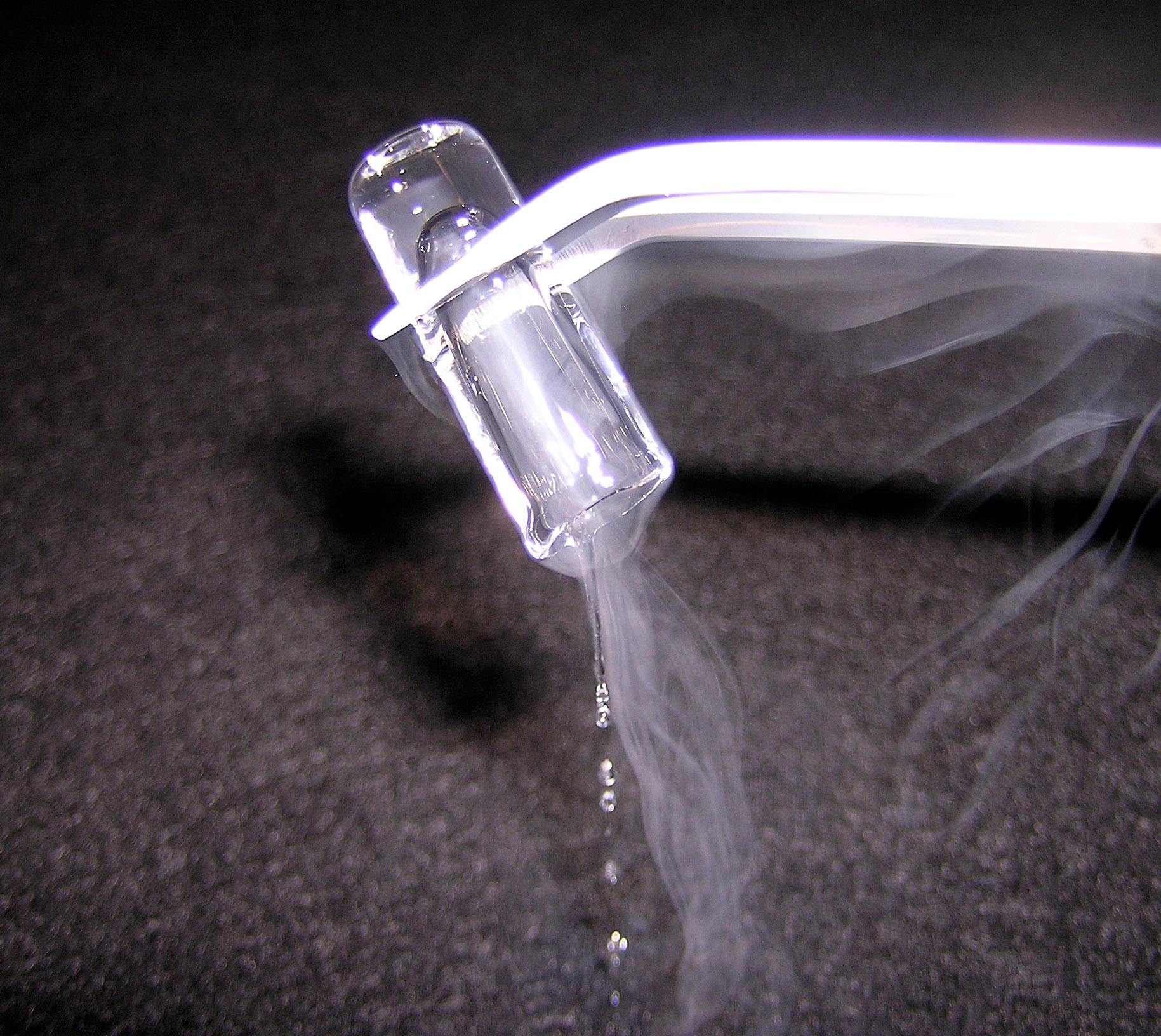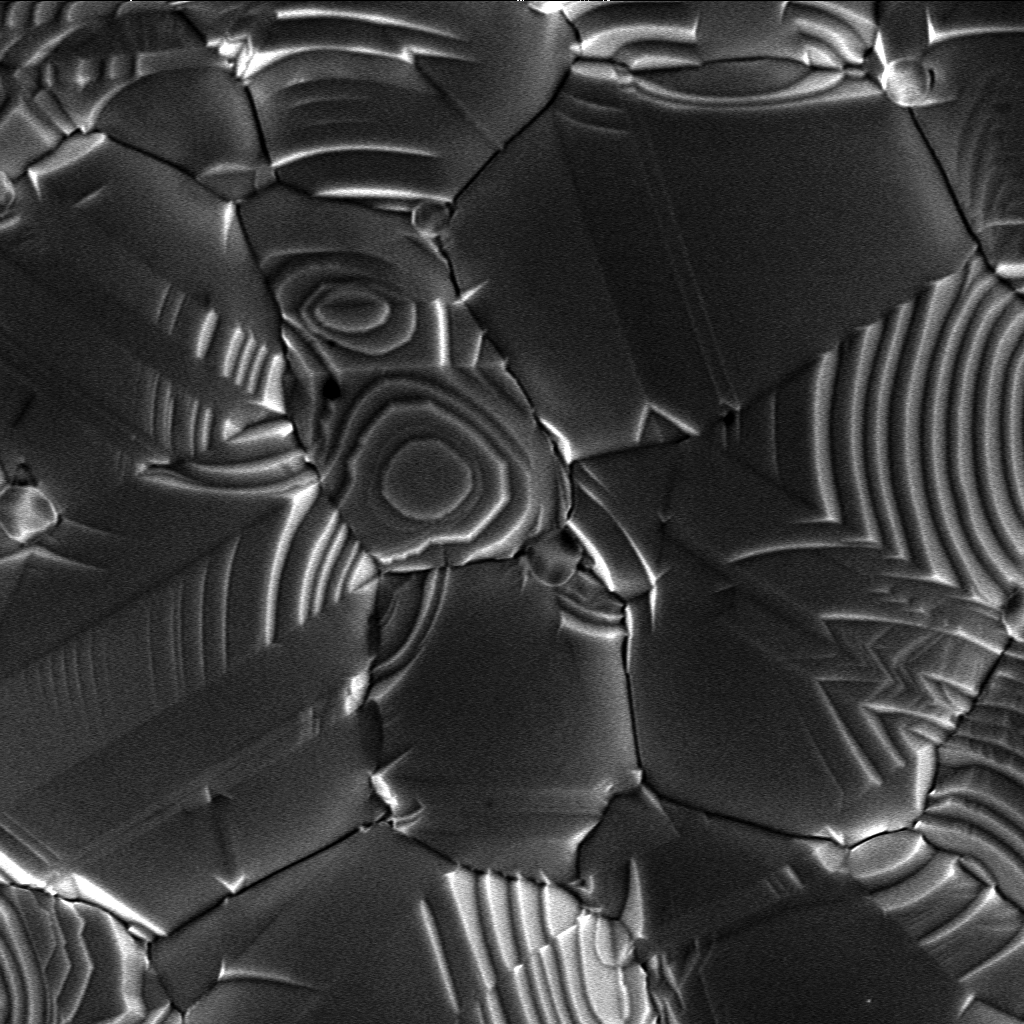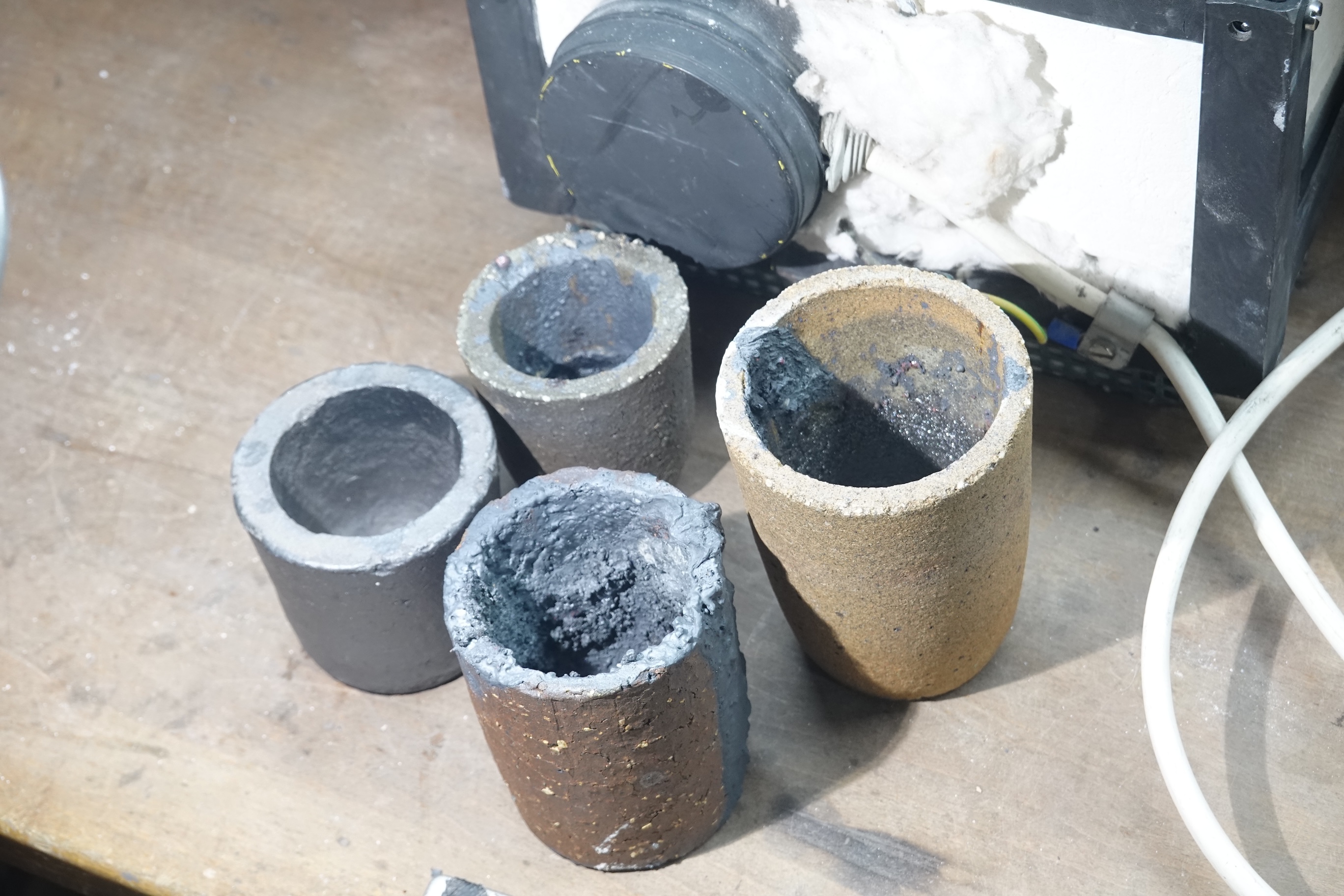|
Lely Method
The Lely method, also known as the Lely process or Lely technique, is a crystal growth technology used for producing silicon carbide crystals for the semiconductor industry. The patent for this method was filed in the Netherlands in 1954 and in the United States in 1955 by Jan Anthony Lely of Philips Electronics. The patent was subsequently granted on 30 September 1958, then was refined by D. R. Hamilton et al. in 1960, and by V. P. Novikov and V. I. Ionov in 1968. Overview The Lely method produces bulk silicon carbide crystals through the process of sublimation. Silicon carbide powder is loaded into a graphite crucible, which is purged with argon gas and heated to approximately . The silicon carbide near the outer walls of the crucible sublimes and is deposited on a graphite rod near the center of the crucible, which is at a lower temperature. Several modified versions of the Lely process exist, most commonly the silicon carbide is heated from the bottom e ... [...More Info...] [...Related Items...] OR: [Wikipedia] [Google] [Baidu] [Amazon] |
|
|
Physical Vapor Transport Crucible-en
Physical may refer to: *Physical examination In a physical examination, medical examination, clinical examination, or medical checkup, a medical practitioner examines a patient for any possible medical signs or symptoms of a Disease, medical condition. It generally consists of a series of ..., a regular overall check-up with a doctor * ''Physical'' (Olivia Newton-John album), 1981 ** "Physical" (Olivia Newton-John song) * ''Physical'' (Gabe Gurnsey album) * "Physical" (Alcazar song) (2004) * "Physical" (Enrique Iglesias song) (2014) * "Physical" (Dua Lipa song) (2020) *"Physical (You're So)", a 1980 song by Adam & the Ants, the B side to " Dog Eat Dog" * ''Physical'' (TV series), an American television series *'' Physical: 100'', a Korean reality show on Netflix See also {{disambiguation ... [...More Info...] [...Related Items...] OR: [Wikipedia] [Google] [Baidu] [Amazon] |
|
 |
Deposition (phase Transition)
Deposition is the phase transition in which gas transforms into solid without passing through the liquid phase. Deposition is a thermodynamic process. The reverse of deposition is sublimation and hence sometimes deposition is called desublimation. Applications Examples One example of deposition is the process by which, in sub-freezing air, water vapour changes directly to ice without first becoming a liquid Liquid is a state of matter with a definite volume but no fixed shape. Liquids adapt to the shape of their container and are nearly incompressible, maintaining their volume even under pressure. The density of a liquid is usually close to th .... This is how frost and hoar frost form on the ground or other surfaces, including leaves. For deposition to occur, thermal energy must be removed from a gas. When the air becomes cold enough, water vapour in the air surrounding a leaf loses enough thermal energy to change into a solid. Even though the air tempera ... [...More Info...] [...Related Items...] OR: [Wikipedia] [Google] [Baidu] [Amazon] |
 |
Crystallography
Crystallography is the branch of science devoted to the study of molecular and crystalline structure and properties. The word ''crystallography'' is derived from the Ancient Greek word (; "clear ice, rock-crystal"), and (; "to write"). In July 2012, the United Nations recognised the importance of the science of crystallography by proclaiming 2014 the International Year of Crystallography.UN announcement "International Year of Crystallography" iycr2014.org. 12 July 2012 Crystallography is a broad topic, and many of its subareas, such as X-ray crystallography, are themselves important scientific topics. Crystallography ranges from the fundamentals of crystal structure to the mathematics of Crystal system, crystal geometry, including those that are Aperiodic crystal, not periodic or quasi ... [...More Info...] [...Related Items...] OR: [Wikipedia] [Google] [Baidu] [Amazon] |
|
Sublimation Sandwich Method
The sublimation sandwich method (also called the sublimation sandwich process and the sublimation sandwich technique) is a kind of physical vapor deposition used for creating man-made crystals. Silicon carbide is the most common crystal grown this way, though other crystals may also be created with it (notably gallium nitride). In this method, the environment around a single crystal or a polycrystalline plate is filled with vapor heated to between 1600°C and 2100°C. Changes to this environment can affect the gas phase stoichiometry. The source-to-crystal distance is kept very low, between 0.02mm to 0.03mm. Parameters that can affect crystal growth include source-to-substrate distance, temperature gradient, and the presence of tantalum for gathering excess carbon. High growth rates are the result of small source-to-seed distances combined with a large heat flux onto a small amount of source material with no more than a moderate temperature difference between the substrate and t ... [...More Info...] [...Related Items...] OR: [Wikipedia] [Google] [Baidu] [Amazon] |
|
|
Czochralski Method
The Czochralski method, also Czochralski technique or Czochralski process, is a method of crystal growth used to obtain single crystals (monocrystals) of semiconductors (e.g. silicon, germanium and gallium arsenide), metals (e.g. palladium, platinum, silver, gold), salts and synthetic gemstones. The method is named after Polish scientist Jan Czochralski, who invented the method in 1915 while investigating the crystallization rates of metals. He made this discovery by accident: instead of dipping his pen into his inkwell, he dipped it in molten tin, and drew a tin filament, which later proved to be a single crystal. The process remains economically important, as roughly 90% of all modern-day semiconductor devices use material derived from this method. The most important application may be the growth of large cylindrical ingots, or boules, of single crystal silicon used in the electronics industry to make semiconductor devices like integrated circuits. Other semiconductors, such as ... [...More Info...] [...Related Items...] OR: [Wikipedia] [Google] [Baidu] [Amazon] |
|
|
Acheson Process
The Acheson process is a method of synthesizing silicon carbide (SiC) and graphite invented by Edward Goodrich Acheson and patented by him in 1896. Process The process consists of heating a mixture of silicon dioxide">Acheson founded the Carbor ... and patented by him in 1896. Process The process consists of heating a mixture of silicon dioxide (SiO2), in the form of silica or quartz sand, and carbon, in its chemical element, elemental form as powdered coke (fuel), coke, in an iron bowl. In the furnace, the silicon dioxide, which sometimes also contains other additives along with ferric oxide and saw dust is melted surrounding a graphite rod, which serves as a core. These rods are inserted in such a way that they are held in contact with each other through the particles of coke, which is commonly called coke bed. An electric current is passed through the graphite rods which heats the mixture to 1700–2500 °C. The result of the carbothermic reaction is a layer of si ... [...More Info...] [...Related Items...] OR: [Wikipedia] [Google] [Baidu] [Amazon] |
|
|
Induction Furnace
An induction furnace is an electrical furnace in which the heat is applied by induction heating of metal. Induction furnace capacities range from less than one kilogram to one hundred tons, and are used to melt iron and steel, copper, aluminum, and precious metals. The advantage of the induction furnace is a clean, energy-efficient and well-controlled melting process, compared to most other means of metal melting. Most modern foundries use this type of furnace, and many iron foundries are replacing cupola furnaces with induction furnaces to melt cast iron, as the former emit much dust and other pollutants. Induction furnaces do not require an arc, as in an electric arc furnace, or combustion, as in a blast furnace. As a result, the temperature of the charge (the material entered into the furnace for heating, not to be confused with electric charge) is no higher than required to melt it; this can prevent the loss of valuable alloying elements. The one major drawback to ... [...More Info...] [...Related Items...] OR: [Wikipedia] [Google] [Baidu] [Amazon] |
|
|
Temperature Gradient
A temperature gradient is a physical quantity that describes in which direction and at what rate the temperature changes the most rapidly around a particular location. The temperature spatial gradient is a vector quantity with Dimensional analysis, dimension of temperature difference per unit length. The International System of Units, SI Units of measurement, unit is kelvin per meter (K/m). Temperature gradients in the Earth's atmosphere, atmosphere are important in the atmospheric sciences (meteorology, climatology and related fields). Mathematical description Assuming that the temperature ''T'' is an intensive quantity, i.e., a single-valued, Continuous function, continuous and Derivative, differentiable Function (mathematics), function of three-dimensional space (often called a scalar field), i.e., that :T=T(x,y,z) where ''x'', ''y'' and ''z'' are the Cartesian coordinate system, coordinates of the location of interest, then the temperature gradient is the vector (geometric) ... [...More Info...] [...Related Items...] OR: [Wikipedia] [Google] [Baidu] [Amazon] |
|
 |
Argon
Argon is a chemical element; it has symbol Ar and atomic number 18. It is in group 18 of the periodic table and is a noble gas. Argon is the third most abundant gas in Earth's atmosphere, at 0.934% (9340 ppmv). It is more than twice as abundant as water vapor (which averages about 4000 ppmv, but varies greatly), 23 times as abundant as carbon dioxide (400 ppmv), and more than 500 times as abundant as neon (18 ppmv). Argon is the most abundant noble gas in Earth's crust, comprising 0.00015% of the crust. Nearly all argon in Earth's atmosphere is radiogenic argon-40, derived from the decay of potassium-40 in Earth's crust. In the universe, argon-36 is by far the most common argon isotope, as it is the most easily produced by stellar nucleosynthesis in supernovas. The name "argon" is derived from the Greek word , neuter singular form of meaning 'lazy' or 'inactive', as a reference to the fact that the element undergoes almost no chemical reactions. The complete oc ... [...More Info...] [...Related Items...] OR: [Wikipedia] [Google] [Baidu] [Amazon] |
 |
Crystal Growth
Crystal growth is a major stage of a crystallization, crystallization process, and consists of the addition of new atoms, ions, or polymer strings into the characteristic arrangement of the crystalline lattice. The growth typically follows an initial stage of either homogeneous or heterogeneous (surface catalyzed) nucleation, unless a "seed" crystal, purposely added to start the growth, was already present. The action of crystal growth yields a crystalline solid whose atoms or molecules are close packed, with fixed positions in space relative to each other. The crystalline states of matter, state of matter is characterized by a distinct structural rigidity and very high resistance to Plastic deformation in solids, deformation (i.e. changes of shape and/or volume). Most crystalline solids have high values both of Young's modulus and of the shear modulus of elasticity (physics), elasticity. This contrasts with most liquids or fluids, which have a low shear modulus, and typically exh ... [...More Info...] [...Related Items...] OR: [Wikipedia] [Google] [Baidu] [Amazon] |
 |
Crucible
A crucible is a container in which metals or other substances may be melted or subjected to very high temperatures. Although crucibles have historically tended to be made out of clay, they can be made from any material that withstands temperatures high enough to melt or otherwise alter its contents. History Typology and chronology The form of the crucible has varied through time, with designs reflecting the process for which they are used, as well as regional variation. The earliest crucible forms derive from the sixth/fifth millennium B.C. in Eastern Europe and Iran. Chalcolithic Crucibles used for copper smelting were generally wide shallow vessels made from clay that lacks refractory properties which is similar to the types of clay used in other ceramics of the time. During the Chalcolithic period, crucibles were heated from the top by using blowpipes.Hauptmann A., 2003, ''Developments in copper Metallurgy During the Fourth and Third Millennia B.C. at Feinan'', Jordan, P ... [...More Info...] [...Related Items...] OR: [Wikipedia] [Google] [Baidu] [Amazon] |
|
Sublimation (phase Transition)
Sublimation is the Phase transition, transition of a substance directly from the solid to the gas state, without passing through the liquid state. The verb form of sublimation is ''sublime'', or less preferably, ''sublimate''. ''Sublimate'' also refers to the product obtained by sublimation. The point at which sublimation occurs rapidly (for further details, see #False correspondence with vaporization, below) is called critical sublimation point, or simply sublimation point. Notable examples include sublimation of dry ice at room temperature and atmospheric pressure, and that of solid iodine with heating. The reverse process of sublimation is deposition (phase transition), ''deposition'' (also called ''desublimation''), in which a substance passes directly from a gas to a solid phase, without passing through the liquid state. Technically, all solids may sublime, though most sublime at extremely low rates that are hardly detectable under usual conditions. At standard condi ... [...More Info...] [...Related Items...] OR: [Wikipedia] [Google] [Baidu] [Amazon] |